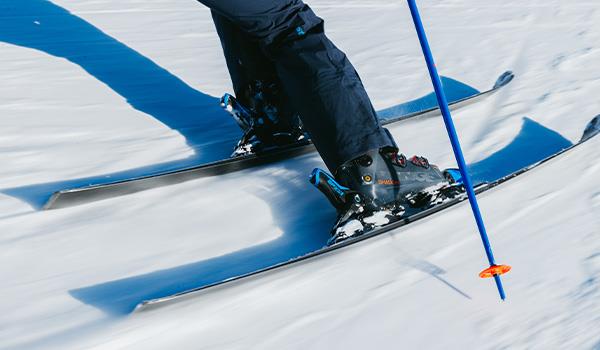Another factor to consider when considering how to pick the right skis is the ski width. There are three numbers to look for—the widest part at the front end of the ski, the narrowest part near the center, and the widest part at the tail end of the ski. Measured in millimeters, these numbers give you a good idea of the shape of the ski, specifically the side cut or the hourglass shape.
When skis were first made, the sides were straight. As skis evolved, skiers found that shaped skis, where the center of the skis is narrower than the tip and tail, are easier to turn when the rolled on their edge.
This parabolic shape influences the size of the turn that the ski makes, known as the turn radius.
A more intense side cut (a greater difference between the width of the tip, width of underfoot, and width of the tail), the shorter the turn radius, where it feels like the skis hook into the turn and create a tighter turn.
The straighter the side cut, where there isn’t as big of a difference between the width of the tip, underfoot, and tail, the longer the turn the ski will make.
Width Underfoot
It’s common for brands to make the same ski in different widths underfoot. This is the narrowest part of the ski, found near the center, and can range from around 70mm wide to 120mm and beyond. The width underfoot impacts how quickly you can turn, rolling from one edge to another.
The narrower the ski, the easier it is to make quicker turns. This is ideal for beginners as they learn to make and connect their turns. Narrower skis are also preferred among intermediate and expert skiers looking for on-trail, carving skis and dedicated mogul skis.
The width underfoot also impacts the ski’s stability at higher speeds and ability to float in powder. The wider the ski, the more stable it will be and the more surface area to float in lighter snow. This is a great choice for intermediate and advanced skiers who want a ski to explore different terrain.
Ski Flex
Ski flex refers to how stiff or soft a ski is. Each ski is made of different layers of material to create a uniquely performing ski.

Ski cores are usually made from composite (also referred to as foam) or wood. Composite cores are softer, lighter, and cheaper than wood cores, making them common among beginner skis.
Wood cores can range from soft to stiff, depending on the type and density of the wood. Some skis are designed with a mix of different woods to create different areas of stiffness throughout the ski. In some intermediate and expert skis, fiberglass, carbon, and/or metal like titanal are layered with the core to create even more rigidity and influence the ski’s flex pattern.
A softer ski is easier to initiate and release from turns and is more forgiving of mistakes. This is ideal for beginner skiers as they learn. It also makes a great choice for those who plan to ride in the terrain park, as it’s easy to maneuver and do tricks.
The downside of having a ski that’s too soft is the chatter and a lack of stability at higher speeds and on steeper terrain.
A stiffer ski provides more stability at higher speeds, more precision on turns, and better edge grip on hard packed snow. Stiffer skis are a common choice for intermediate and expert skiers, especially those who like to ski aggressively on steep terrain. However, a too stiff ski will be difficult to control for inexperienced skiers, requiring a lot of effort and throwing you around on varied terrain.
When determining via a ski buying guide which flex and stiffness is right for you, it’s important to consider your ability, strength, weight, and aggression on the mountain. Beginner skiers may opt for a softer ski, while more experienced skiers may want a stiffer ski. Those who weigh more, are strong skiers, or those who ski aggressively may prefer a stiffer ski. However, lighter or more cautious skiers may prefer a softer ski.
Back to Top